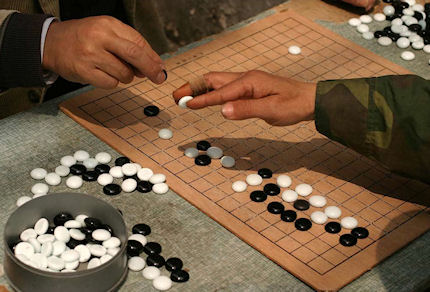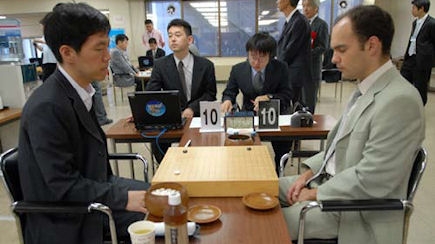This article first appeared in the May/Jun 2011 issue of World Gaming magazine.
Our last issue included an article explaining the history of the board game ‘Go’. Let’s now move on to the rules of the game.
Go is said to be based on war, and as you learn the game you will probably notice it has many similarities to war strategy. Like many games Go has different rule sets dominating in different regions, but with Go the differences are mainly to do with scoring (this is further explained in the ‘scoring’ section below), and these differences do not greatly affect the strategies of the game.

The ancient game of Go
The stones, board and moves
Go is played between two players, one using black stones and the other white stones, with each player placing a single stone on his move (with the only possible exception being black’s first move, this is explained in the ‘handicap’ section below). The moves alternate between the two players. Either player may pass his turn at any time, but of course he would do so only if he believed there are no moves to his advantage remaining. Usually this happens late in the game. Since black makes the first move, the weaker of the two players takes the black stones. If players are of a similar skill, the colours are allocated randomly. Unlike other board games such as chess, the stones are placed on the intersection of the board’s grid lines rather than inside the squares. Stones may be placed on the edges and corners, just like any other intersection. The board is a square of 19 x 19 grid lines, so there are 361 intersections in total.
Handicap
If there is a substantial skill difference between the players, sometimes the weaker player is given a handicap. He is allowed to take the black stones, thus moving first, and sometimes on his first move instead of placing the usual one stone, he is allowed to place up to nine stones (depending on the size of the handicap).
Objective
Much like war, the objective of the game is to obtain territory by surrounding it. A player can also capture his opponent’s stones (and thus more territory) by surrounding them. Territory and capture are both explained in more detail below.
Chains and groups
Stones can be linked by placing them adjacent to one another either vertically or horizontally (but not diagonally) to form a chain (sometimes called a string). Once a chain has been formed it cannot be divided into smaller chains and essentially becomes one large stone. The chain does not have to be one single line of stones; a single chain can have multiple interconnected lines of stones. As the chain matures and grows more than a few lines, players tend to think of the chain as a ‘group’, nevertheless under the rules there is no difference between a chain and a group.

Liberties
As indicated by the black and white dots in the diagram, the vacant intersections on the board neighbouring each stone are known as ‘liberties’. A liberty for any particular stone is a liberty for every single stone in its chain. At least one liberty must be present to allow that chain to remain on the board. Liberties can be thought of as ‘escape routes’.
Territory
Territory refers to empty space that is completely surrounded by a player’s stones. For example, in the diagram below the player with the white stones has surrounded nine intersections of territory (remember to count the intersections on the edges).

Prohibition against suicide
A player cannot make a move by placing a stone that leaves the board in the exact same position it has been at some earlier point in the game. However, a player may simply pass on his move. In some rule sets the prohibition against repetition is only a prohibition on immediate repetition, in other words it is a prohibition on re-creating the board position that existed immediately before the immediately preceding move.
Capturing stones
To capture your opponent’s stones you must surround the entire chain so that it has no liberties remaining. This includes liberties on the inside of your opponent’s group. When a chain is surrounded in this way, the captured stones are removed from the board. Under some rules sets, such captured stones are said to be ‘prisoners’, and each prisoner will count as one point in the scoring at the end of the game. Under other rule sets, these captured stones are merely returned to your opponent’s bowl of stones. In the example on the left, if white plays at intersection A then black’s chain loses all of its liberties and is removed from the board.
Eyes
An eye in a group of stones is a single empty intersection that is surrounded on all four sides by friendly stones, into which the enemy can never place a stone due to the prohibition against suicide.

Life and death
A group of stones is said to be alive when it has two eyes in it. One eye is not sufficient, because if the single eye is the last liberty of the group, when the enemy plays his stone into the single eye the entire group will be captured, and thus the prohibition against suicide has not been violated. There is a rare exception to the ‘two eye’ rule. Sometimes a group can be alive due to having liberties on it’s outside that are also liberties for an enemy group (these are called ‘shared liberties’). Groups that have only one eye and cannot create another (or cannot connect to another group with at least one eye) are doomed to eventual death.
End of the game
Remember, either player may pass his turn at any time. If both players pass consecutively, the game is over. In practice the players often end the game before playing it completely out, by agreeing whichgroups are alive and which are dead, and immediately removing the dead stones. Actually playing out the game to capture obviously dead groups is considered a waste of time and unsportsmanlike. But if there is any doubt in either player’s mind, then it is okay to continue to play the game out.
Scoring to determine the winner
Under the Japanese and Korean rules, territory scoring is used. Under the Chinese rules, area scoring is used. For any particular game, both systems almost always result in the same winner.
We have already defined territory: it is the number of intersections that are completely surrounded by a player’s stones. Area is simply territory plus the number of stones a player has on the board. A layman’s way of thinking about it might be that territory is all the land surrounded by a player’s soldiers, whereas area is all the land surrounded by a player’s soldiers plus all the land his soldiers are camped on!
Under area scoring, a player’s final score is simply the number of intersections in his area. Under territory scoring, the final score is the number of intersections in a player’s territory plus the number prisoners he captured during the course of the game.
This has be
en a fairly detailed description of therules of Go. Whilst there are some other minor rules and variations, what has been discussed here is more than enough to see you sitting down and enjoying the game.However, understanding the nuances and strategies of the game can take a lifetime. If you are looking for a new challenge, then this widely played and respected game could be for you – why not give it a go?







